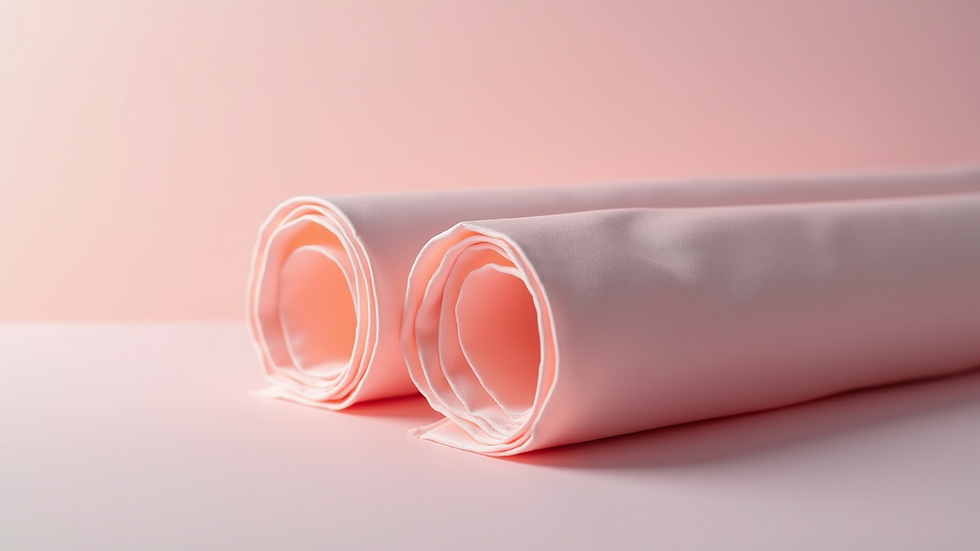The Ultimate Guide to Choosing the Perfect Wedding Dress Material for Your Special Day
- donaldfery
- Mar 25
- 4 min read
Choosing the perfect wedding dress material is a crucial step in the journey of planning your dream wedding. The fabric you select not only establishes the overall aesthetic of your dress but also impacts its comfort, drape, and seasonality. With so many options available, it can feel overwhelming to know where to start. In this comprehensive guide, we'll explore various wedding dress materials, their qualities, and what might work best for different styles and settings.
Understanding Various Fabrics
When it comes to wedding dresses, several fabrics are commonly used. Each has its own set of characteristics that can influence the style and fit of the dress.
Silk
Silk is often considered the epitome of luxury when it comes to fabrics. It's soft, luminous, and drapes beautifully, making it a popular choice for a classic and elegant look.
Silk comes in different varieties, from lightweight chiffon to heavier satin. Each type has its unique qualities. For example, chiffon is ethereal and flowy, whereas satin gives a more structured appearance.
Whether you're dreaming of a flowing A-line dress or a fitted sheath, silk can help you achieve that perfect silhouette.

Lace
Lace adds a timeless charm to wedding dresses, making it a favorite for both traditional and modern designs. It is often used as an overlay, providing texture and detail to the gown.
The intricate patterns found in lace can elevate a simple dress into a stunning masterpiece. Plus, lace comes in various styles, from delicate floral motifs to bold, geometric designs.
When incorporating lace into your wedding dress, consider whether you want it to play a major role or serve as an accent to other materials.

Tulle
Tulle is a lightweight fabric often used to create volume and dimension. It has a net-like texture that is perfect for ball gowns and A-line dresses.
Tulle can be layered to create a dreamy, fairytale look, and it is frequently used in skirts, veils, and overlays. Its sheer nature allows for creativity, as it can be combined with other fabrics like satin or lace for added elegance.
For an outdoor wedding or a whimsical theme, tulle could be your best friend.

Choosing the Right Material Based on Season
The season in which you’re getting married should significantly influence your choice of fabric.
Spring and Summer Weddings
For warm-weather weddings, lightweight materials are essential. Fabrics like chiffon, organza, and tulle are breathable, keeping you cool throughout the event.
Chiffon, for instance, has a flowing quality that allows for movement without clinging to the body. Lane these fabrics with a simple silhouette for a romantic vibe.
Fall and Winter Weddings
Colder months call for heavier fabrics that provide warmth without sacrificing style. Look toward satin, velvet, and brocade, which offer an opulent feel and a luxurious finish.
These heavier materials can also translate beautifully into more structured designs, giving you the chance to play with dramatic shapes and styles.
Dress Style and Fabric Compatibility
Not all fabrics complement every dress style. Understanding the relationship between your chosen silhouette and the material is key.
A-Line Dresses
A-line gowns are versatile and can be made from just about any fabric. However, silk and chiffon work beautifully here, providing a flowing effect that flatters a variety of body types.
Mermaid and Fit-and-Flare Styles
For these fitted silhouettes, consider fabrics that offer a bit of stretch. Mikado, which is a blend of silk and nylon, provides structure while remaining flattering. This fabric allows for a fitted look without sacrificing comfort.
Ball Gowns
If you envision a fairytale ball gown, tulle is a must-have. The weightlessness of layered tulle creates a magical, full-skirted effect that lifts and twirls with you as you move.
Considering Comfort
While appearance is crucial, don’t overlook comfort. You’ll want a fabric that feels good on your skin and allows ease of movement, especially if you plan to dance the night away.
Breathability
Fabrics like chiffon and lace are great choices for their breathable nature, ensuring you stay cool and comfortable. Also, consider the lining of the dress; a breathable cotton or silk can further enhance your comfort.
Weight
Keep an eye on the weight of the fabric, especially if you have a long wedding day ahead. Heavier fabrics can be uncomfortable after several hours of wear, whereas lighter fabrics might be more suitable for a long event.
Budget Considerations
Wedding dress fabrics can range widely in price. Keep your budget in mind when selecting your material.
Quality vs. Cost
While it's tempting to opt for more affordable fabrics, remember that quality often translates to a more beautiful final product. Silk and lace may come at a premium, but their appearance and feel can make a significant difference on your big day.
Alternatives to High-End Fabrics
Don't fret if your budget is tight. Blends and synthetic fabrics can offer similar looks at a lower cost. Fabrics like polyester and nylon can mimic the appearance of silk or tulle but are often more budget-friendly.
Conclusion
Choosing the right wedding dress material is pivotal in achieving your dream dress. From luxurious silk to delicate lace and voluminous tulle, each fabric offers unique qualities that contribute to the overall design and feel of your gown.
By considering factors such as season, dress style, comfort, and budget, you can make an informed decision that results in a stunning and comfortable wedding dress. This choice will not only help you look beautiful but will also ensure that you feel confident on your special day.
As you embark on this exciting journey, remember to enjoy the process of finding the perfect fabric that resonates with your personal style and enhances your wedding experience. Happy planning!



Comments